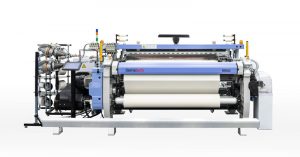
The star of the weaving room continues to advance, offering added value and higher quality to finished products.
TW Special Report
Even though, in most cases, the weaving process is the same as it ever was — create a shed, insert the filling and beat up the pick — today’s weaving machines are highly technical instruments featuring numerous innovations that have sped-up production, improved quality and saved energy.
Many of the latest developments in weaving machines have focused on automation, digital upgrades and innovative end products that add value including technical textiles, e-textiles and 3D structures.
“With labor shortages impacting every weaving mill in North America, we see increasing demand from our customers for automation technologies for the weaving mill,” said Oliver Meier, Textile director, North America, Stäubli. “Additionally, in the residential contract business, we see a trend developing for greater jacquard machine flexibility to address a wide range of fabric constructions that can satisfy market demands faster.”
Here, Textile World presents a few of the weaving machine innovations available to weavers in all end-use markets.
Weaving Machines
Italy-based Itema S.p.A. today combines the historic weaving brands of Somet, Sultex and Vamatex, which the company reports “combines Swiss precision with Italian creativity.” In 2019, the company also established Itematech — a new technical division devoted to weaving machines for technical fabrics — after it acquired Italy-based Panter/PTMT. The alliance of Itema with Panter produced a product portfolio that includes negative and positive rapier machines as well as air-jet and projectile offerings. The company established Itematech with the aim of providing technical fabric producers a partner that offers a complete range of weaving solutions and a skilled technical team to help fulfill specific customer requirements for technical fabrics.
Itema reports the Itematech A95002 air-jet weaving machine is especially welcomed in demanding weaving markets in the United States, Russia and India, among other countries. The machine combines two Itema technologies — for shed geometry and air-jet weft insertion — to guarantee high-quality fabrics even when weaving at high speeds.
The machine was tested in real-world scenarios during customer trials; and according to Itema, the A95002 demonstrated the ability to avoid “so-called ‘snarls,’” and also delivered “excellent results” when weaving high-density fabrics. Itema customers are currently using the machine for medical, automotive and parachute applications, among other applications.
The A95002 features a reinforced whip roller that eliminates friction to improve warp tension control and reduce warp stops. The machine also has a longer dwell time for the cam sley drive to allow a longer weft insertion time for more efficient weft filling. The machine’s double tandem nozzles also play a key role when weaving the coarsest yarns at high speeds. Itema offers two technologies for leno binding on the A95002. The patented Electronic Leno Device (ELD), features an innovative design that guarantees perfect leno binding with reduced operational costs, according to the company. The Rotary Leno Device (RLD) is suitable for most man-made fiber yarns.
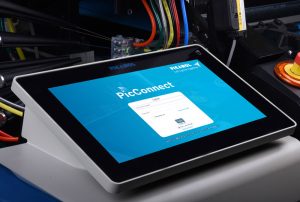
Belgium-based Picanol NV specializes in air-jet and rapier weaving machines. The company recently introduced the TerryPlus-i air-jet weaving machine with a completely new pile formation system capable of creating any pile height from 0 to 12 millimeters on a pick-by-pick basis regardless of the pattern. “It doesn’t matter if it’s high pile, low pile, high density, low density, complex styles or simple styles — [the TerryPlus-i] can handle any challenge,” said Johan Verstraete, vice president, Weaving Machines, Picanol.
Other innovations include:
- the GTMax-i 3.0S rapier weaving machine with full electronic monitoring and control, SUMO main motor and microprocessor-controlled filling insertion; and
- the OptiMax-i rapier machine designed for gentle treatment of all kinds of weft yarns; and may be easily modified, retrofitted and upgraded as needed as a result of its modular design concept.
Picanol just launched PicConnect, a new fully digital platform that supports Internet of Things (IoT) and service-related applications, and also acts as a gateway to all Picanol’s digital services. The web-based, cloud application may be accessed using a web browser on any device. All machines can be connected to the cloud to leverage all four of the platform’s applications — production monitoring, energy monitoring, style administration and PartsLine, Picanol’s new online web store.
Using the production monitoring application, users can track production in real-time and immediately react to operational tasks to increase efficiency and view historical data to determine where action may need to be taken to optimize production.
PicConnect’s energy monitoring application surveils air and power consumption of the weaving machines. According to Picanol, insight into the energy flow in the weave room can help reduce overall energy costs.
Machine settings may be opened, edited and managed quickly using PicConnect’s style administration application. Operators can compare and copy settings between machines on the plant floor ensuring each machine is operating under optimal settings for each fabric woven.
PicConnect’s PartsLine online web store for spare parts allows customers to receive price quotes, review orders and receive invoices.
“PicConnect is a new platform that makes it possible for weavers to quickly react to changes in the weave room, and that will have an immediate impact on the performance of the machines in various aspects,” said Erwin Devloo, Picanol’s marketing communication manager. “This new Picanol platform is only the start of a whole new story with new applications in the future that Picanol is continuously working on.”
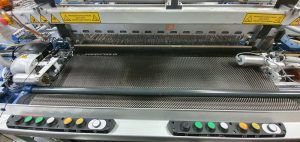
Italy-based SMIT joined the Santex Rimar Group a few years ago. The company has been manufacturing weaving machines since 1938, specializing in rapier technology.
SMIT most recently introduced the 2FAST rapier weaving machine. The name FAST is an acronym for Flexible Advanced Shuttleless Technology. SMIT relates the engineering of its 2FAST “racing machine” to the country’s tradition and expertise in motor sports. According to SMIT, the 2FAST shows high starting acceleration and 100-percent beat-up efficiency right from the first weft insertion. The machine also features maximum torque for heavy shedding requirements, and minimum vibration even at top operating speeds. The modular concept machine incorporates the new leno-force system, which is adaptable for different fabric types. Operators can program the false selvedge and leno yarn crossing pick-by-pick for each side of the fabric independently to control weft stretching and reduce weft tail. A new patented gripper design works will all weft yarns and fabric styles; and 2FAST can also handle fancy articles with weft yarns that vary in size and style. The machine was also designed with energy-saving goals in mind. 2FAST is suitable for apparel, denim and home textile fabrics, as well as technical fabrics.
“Software-based control and automation, smart algorithms and data analysis — it’s all embodied in this rapier loom, which is ready for Industry 4.0,” said Giuseppe Castelli, chief technology officer, SMIT. “We are very proud of all advantages embodied in the compact design of the new 2FAST and we are glad to speak it out loud — while also using advanced technology to make the machine itself even quieter.”
SMIT also offers the ONE modular concept based on the GS940 Smart Platform architecture. The company reports the machine is “extremely” versatile thanks to its dynamically controlled flexible tape rapier that works with reed widths between 140 to 220 centimeters. The insertion system is based on just the one rapier with no weft transfer taking place in the middle of the shed. Speeds This mode of operation allows low weft tensions to be used and reduces the warp shed amplitude for increased efficiency, reduces the machine’s energy consumption, makes style changes faster, and increases the range of yarns that the machine can handle, according to SMIT. The company’s Free Flight Ribbon System also eliminates the ribbon guide hooks for further reduced operating costs. ONE will produce high-quality fabrics for any sector, carbon fiber technical fabrics included, according to SMIT.
After the second World War, Germany-based Lindauer Dornier GmbH turned to engineering weaving machines when the company was prohibited from manufacturing aircraft in Germany. Today, the company engineers rapier and air-jet machines that are particularly suitable for technical weaving applications such as airbags and bulletproof products, but also capable of producing pure silk fabrics, jacquard items and delicate worsted fabrics.
According to the company, the Dornier P2 rapier machine is a most flexible weaving machine. “We cover the entire spectrum of fabric production from very fine to very coarse fabrics,” said Wolfgang Schöffl, head of Dornier’s weaving machine product line. The company reports some customers are using the P2 for filtration fabrics. “In order to continuously improve the tightness and quality of filter fabrics, we are further developing our machines in close cooperation with our customers,” Schöffl said.
Other customers are using the P2 to weave fabrics for artistic installations. Bulgarian artist/sculptor Christo, known for his fabric-wrapped creations and outdoor sculptures created with his wife Jeanne-Claude, passed away in 2020 before he was able to carry out a planned exhibit to cover the Arc de Triomphe in Paris. However, his nephew Vladmir Yavachev, set out to accomplish Christo’s last work, and the fabric produced for the installation was created using Dornier’s P2 weaving machine. Some 25,000-square-meters of silver-blue recycled polypropylene coated fabric was woven by Germany-based SETEX Textil. “Only one weaving machine came into question for this demanding fabric,” said Konrad Schröer, owner and managing director of Setex. “The ideal solution is the P2 with its new shed geometry and increased performance in combination with our experienced weavers and their textile know-how.”
The P2 rapier machine is also an integral part of Dornier’s Composite Systems® product line (See “Reintroducing DORNIER’s Composite Systems® Suite,” TW, this issue”).
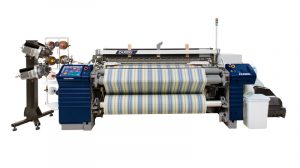
Tsudakoma Corp. is a Japan-based manufacturer of air-jet and water-jet looms. The company recently introduced the ZAX001neo air-jet loom and the ZW8200 water-jet loom. Both machines feature a newly designed robust frame structure.
On the air-jet loom, this new frame contributes 30-percent reduction in vibration compared to its predecessor, the ZAX9200i. Among many features of the new model, the ZAX001neo features an integrated auxiliary main nozzle in a pipeless system, which reduces residual compressed air and increases the weft feeding force to minimize broken or slack picks. The FDP-A IV Electronic Free Drum Pooling System ensures stable weft insertion, and makes possible soft weft insertion for sensitive yarns. The pre-winding direction on the FDP also may be adjusted to account for the twist direction of the yarns being woven. Tsudakoma also designed a new heddle frame for ultra-high-speed production.
Tsudakoma reports the new ZW8200 water-jet weaving machine offers a 10-percent increase in machine rpms, a 10-percent reduction in water consumption, and is clean to operate with a 70-percent reduction of grease into the drainage system, compared to existing models.
The company also offers the CR3300 for technical fabrics such as composite fabrics, or those made using carbon, aramid or glass fibers. The CR3300 features a one-side band rapier mechanism with guideless and slay running system; explosion-proof electric components to prevent fire from carbon flies; a positive cam for 1/1 plain or twill weaves; and regular or special feeders depending on whether twisted or flat weft yarns will be used.
Belgium-based Van de Wiele NV has been a player in the carpet weaving market since 1880. The company’s face-to-face carpet weaving technique first creates a 3D structure by connecting pile yarns between two ground structures. The pile yarns are then cut down the middle to produce two symmetrical carpets. The Rug & Carpet Expert RCE2+ is Van de Wiele’s latest generation double rapier face-to-face carpet weaving machine. According to the company, the technology features fewer mechanics and more electronics for high-capacity production.
The company also offers velvet and technical fabric weaving machines, finishing machines, and bulk-continuous filament extrusion lines. Earlier this year, Van de Wiele acquired the Italy-based Savio Group, further diversifying its textile portfolio with the addition of yarn winding and quality control devices.
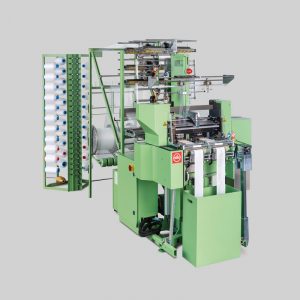
NFM® with MDW® thread placing device
Narrow Fabrics: Müller
Switzerland-based Jakob Müller AG Frick has 134 years of know-how in narrow fabric weaving. Its machinery is used to create products for a myriad of end products including those used in automotive, fashion, industrial, medical and home textile applications.
The NFM® is Müller’s latest generation of narrow fabric loom. This universal series of machine’s is based on the company’s successful NF and NH looms, and was designed for light- to medium-weight elastic and non-elastic narrow fabrics made using all yarn types. The machine is available in two base models — the NFM 53 and NFM 80.
According to the company, the machines are simple to modify or convert because of a modular design. Customers can easily exchange weaving heads to change the tape width, exchange a complete cross beam, expand the machine to Müller’s NFMJ, and the machines also are prepared for MDW®, its Multi Directional Weaving functional and effect thread placing device.
The NFM series features infinitely adjustable, electronically controlled stepper drives for the weft, binder and locking threads, rubber transport and fabric take-off. An electronic main drive also may be regulated at any time. NFM machines feature a MÜDATA M touch screen and the latest MLC control system with networking capability.
Müller also offers the MÜGRIP® MBJ8 1/1380 label weaving machine for labels and pictures with slit selvedges. The machine has a maximum nominal width of 1,346 millimeters. Features include the SPE3/SPE3M jacquard head; MLC machine control/network ready; Müdata M touchscreen; rapier drive; lightweight universal rapier for extended head and tape life; and electronically controlled IRO Luna X3 weft thread feeders for up to 12 colors.
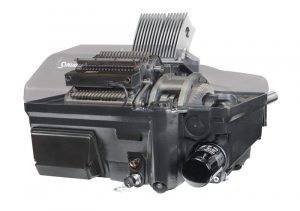
Shedding Technologies: Stäubli
Switzerland-based Stäubli Group, with its U.S. textile headquarters located in Duncan, S.C., specializes in shedding solutions for both frame and jacquard weaving, weaving preparation technologies (See “Weaving: Auxiliary Equipment Matters,” TW, this issue ), and carpet weaving machines under the Schönherr Stäubli brand name.
“Our customers are looking for solutions that are adapted to their needs to stay at the forefront of their market,” said Fritz Legler, marketing and sales, Stäubli. “We provide quality, high-speed machinery made of first-class materials combined with ingenious R&D as a result of our long-lasting experience and partnering with our customers.”
Stäubli offers the high-speed S3200 series of electronic rotary dobbies for air-jet weaving along with maintenance-free harness motions. According to the company, integrating such a combination into the weaving machine is a key to precise shed formation when the highest operating speeds and precision are required. Stäubli also offers the S1600 and S1700 series cam motions for plain weaves, such as denim, on air-jet and rapier weaving machines.
Stäubli is well-known for its extensive range of jacquard weaving machinery for a variety of applications including flat fabrics, terry, carpeting, velvets, narrow fabrics and technical fabrics. Technologies include:
- LXXL Series, which supports any large weaving pattern from airbag to upholstery weaving where repeats are not necessary.
- LX and LXL, which support multi repeat to single repeat weaving. The LXL12288 and LXL14336 — where 12,288 and 14,336 denotes the number of hooks available to control the warp — are used in one-piece woven airbag applications.
- SX, a workhorse jacquard machine for all types of fabrics requiring 2,688 warps ends or multiples of that number.
- LX2493 jacquard machine for technical and carpet solutions with one of the largest shed openings on the market, according to Stäubli.
- N4L, which was designed to support dobby weavers who wish to add a unique look or brand name in the selvedge.
- UNIVAL 100, which is Stäubli’s most versatile jacquard machine featuring an individual servo motor, called an actuator, to control each warp thread.
Customers in the technical weaving arena can also take advantage of Stäubli’s new TF weaving system series dedicated to reinforcing multilayer fabrics made using carbon or aramid, and heavy industrial fabrics. The series may be paired with the S2688 or Unival 500 for dobby weaving; or the LX2493 or Unival 100 plus Stäubli harnesses for most complex jacquard applications.
September/October 2021




